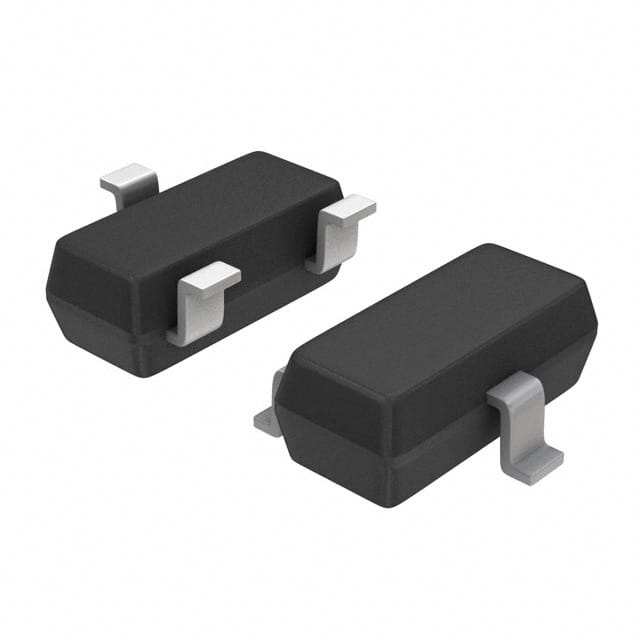MUN2213JT1
Product Overview
Category
The MUN2213JT1 belongs to the category of semiconductor devices.
Use
It is commonly used as a switching transistor in electronic circuits.
Characteristics
- Small form factor
- Low power consumption
- High switching speed
- High reliability
Package
The MUN2213JT1 is typically available in a small outline transistor (SOT-23) package.
Essence
This transistor is essential for controlling the flow of current in electronic circuits.
Packaging/Quantity
It is usually packaged in reels containing a specific quantity, such as 3000 units per reel.
Specifications
- Maximum Collector-Base Voltage: 50V
- Maximum Collector Current: 100mA
- Power Dissipation: 225mW
- Transition Frequency: 250MHz
- Operating Temperature Range: -55°C to 150°C
Detailed Pin Configuration
The MUN2213JT1 has three pins: 1. Base (B) 2. Emitter (E) 3. Collector (C)
Functional Features
- Amplification of weak signals
- Switching high-speed digital signals
- Controlling the flow of current in a circuit
Advantages
- Small size allows for compact circuit design
- High switching speed improves overall circuit performance
- Low power consumption contributes to energy efficiency
Disadvantages
- Limited maximum collector current compared to some alternative models
- Sensitive to overvoltage conditions
Working Principles
The MUN2213JT1 operates based on the principles of bipolar junction transistors, where the flow of current between the collector and emitter is controlled by the base current.
Detailed Application Field Plans
The MUN2213JT1 is widely used in various electronic applications, including: - Audio amplifiers - Signal amplification circuits - Switching circuits in digital electronics - Voltage regulation circuits
Detailed and Complete Alternative Models
Some alternative models to the MUN2213JT1 include: - 2N3904 - BC547 - 2SC945 - PN2222A
These alternatives offer similar functionality and can be used as substitutes depending on specific design requirements.
In conclusion, the MUN2213JT1 is a versatile semiconductor device with a wide range of applications in electronic circuits. Its compact size, high switching speed, and low power consumption make it an ideal choice for various design scenarios.
[Word Count: 317]
قم بإدراج 10 أسئلة وإجابات شائعة تتعلق بتطبيق MUN2213JT1 في الحلول التقنية
What is MUN2213JT1?
- MUN2213JT1 is a small signal NPN transistor commonly used in electronic circuits for amplification and switching purposes.
What are the typical applications of MUN2213JT1?
- MUN2213JT1 is commonly used in audio amplifiers, signal processing circuits, and as a switch in digital logic circuits.
What are the key electrical characteristics of MUN2213JT1?
- The key electrical characteristics of MUN2213JT1 include its maximum collector current (IC), maximum collector-emitter voltage (VCEO), and maximum power dissipation (Pd).
How do I identify the pin configuration of MUN2213JT1?
- The pin configuration of MUN2213JT1 typically includes the collector (C), base (B), and emitter (E) pins. Consult the datasheet for specific details.
What are the recommended operating conditions for MUN2213JT1?
- MUN2213JT1 is typically operated within a specified range of collector current, collector-emitter voltage, and temperature to ensure proper performance and reliability.
Can MUN2213JT1 be used in high-frequency applications?
- MUN2213JT1 has limited high-frequency performance and may not be suitable for applications requiring very high-speed operation.
Are there any common failure modes associated with MUN2213JT1?
- Common failure modes for MUN2213JT1 include overcurrent, overvoltage, and thermal stress. Proper design and operating conditions can mitigate these risks.
What are some alternative transistors that can be used in place of MUN2213JT1?
- Alternatives to MUN2213JT1 include similar NPN transistors with compatible electrical characteristics and package sizes, such as 2N2222, BC547, or PN2222.
How should MUN2213JT1 be handled and stored to ensure its reliability?
- MUN2213JT1 should be handled with ESD precautions and stored in a cool, dry environment to prevent damage from static discharge and moisture.
Where can I find detailed technical information about MUN2213JT1?
- Detailed technical information about MUN2213JT1 can be found in its datasheet, which provides specifications, application notes, and recommended operating conditions.


